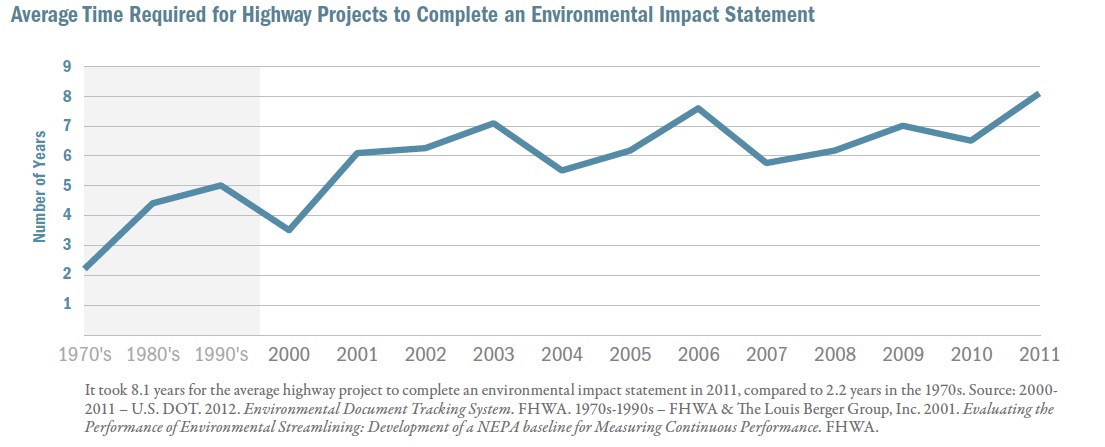REGIONAL PLAN ASSOCIATION
Executive Summary
In the 40 years since the passage of the National Environmental Policy Act and the development of the current federal regulatory process, the practice of completing environmental reviews for major infrastructure projects has significantly lengthened average project delivery times. For example, in 2011, the average time it took to complete an environmental impact statement on a highway project was over eight years, compared with two years just after the law was passed. And yet experience has shown that the law itself still provides a strong regulatory framework that ensures adequate protection for the environment, a process for reaching informed investment decisions, and sufficient flexibility to comply with environmental requirements in an expedited manner. It is the misguided implementation of the law that has significantly affected project delivery time.
This report focuses on common federal and state agency implementation practices of the National Environmental Policy Act – or NEPA – that lead to delays, which are often overlooked in discussions of streamlining the environmental review process. Delays during the NEPA process are often caused by:
- Lack of stakeholder consensus over fundamental aspects of a project, which are not efficiently resolved during the environmental review process;
- Differing and conflicting interpretations of NEPA requirements, and inconsistent implementing policies and procedures among the multitude of government agencies;
- Administrative bottlenecks and outdated procedures within agencies that have insufficient staff capacity and training to efficiently complete environmental studies or reviews; and
- Misdirected response to the threat of environmental litigation, which leads to overly complex and technical environmental analysis and rigorous documentation efforts.
Proposals to expedite the environmental review process originating in Congress often focus on changes to NEPA law, rather than the procedural causes of delay described in this paper. While federal legislators are naturally drawn to legislative solutions, the dismantling of the NEPA law would erode important environmental protections without necessarily addressing the procedural causes of delay that bog down the process. Our consultations with practitioners of the environmental review process offer several examples of environmental reviews that met high environmental standards and were completed in a timely fashion. These examples, however, tend to be the exception to the rule, and their practices are not often repeated. This may be changing with new federal initiatives, although it is too soon to judge the impact of these new measures.
Adopting new procedures and changing agency practices is difficult but achievable. Making progress towards timelier and more efficient environmental review will require adopting and sharing best practices across agencies in the federal government and between federal, state, and local levels. Better and more implementation-focused training is required to equip the current and next generation of environmental practitioners with these best practices. Advances in technology and data management can also help achieve better and timelier outcomes and create good administrative records that help protect the lead agency in case of lawsuits. Finally, it is essential that the environmental review process not be used as a process by which to solve intractable or fundamental conflicts among project stakeholders. Often times, an EIS is moved forward to show progress, expending valuable staff resources and wasting time, while fundamental conflicts remain unresolved.
A project with strong leadership and stakeholder consensus on the problem statement and the need for a solution that enters the NEPA process is much more likely to emerge from it with the necessary approvals in an efficient manner than projects with key issues left unresolved. Sometimes, the best way to avoid delay is to avoid the NEPA process until strong leadership and consensus can be obtained. In this spirit, this report offers the following recommendations to federal and state agencies, environmental practitioners, and process reformers:
- Integrate planning and environmental reviews. Establish broad agreement among agencies and stakeholders on project goals and carry them forward into the environmental process to help prevent controversies from arising later on.
- Front-load agreements among agencies. Spend more time at the beginning of the process establishing memoranda of understanding among participating agencies on timelines, procedures, language, and environmental outcomes.
- Establish stronger federal leadership on major projects. Strengthen federal leadership on major employment-generating projects and reduce federal involvement in minor projects. Allocate sufficient funding and staff capacity to federal agencies to take on stronger leadership roles.
- Train the next generation of environmental practitioners. Educate environmental professionals to adopt and share best practices, such as streamlined stewardship and environmental performance commitments, for more efficient and effective reviews.
- Increase transparency and accountability. Environmental practitioners should focus on producing a more thorough administrative record, as opposed to excessive analysis of unlikely impacts. Greater transparency and accountability can also be achieved by posting the deadlines for key decision points online.
- Update procedures for the 21st century. Take advantage of information technologies, such as digital submission and transmission of environmental documents, and web-based interactive stakeholder involvement tools to improve the efficiency of the NEPA process.
About Regional Plan Association
www.rpa.org
“Regional Plan Association is America’s oldest and most distinguished independent urban research and advocacy group. RPA prepares long-range plans and policies to guide the growth and development of the New York- New Jersey-Connecticut metropolitan region. RPA also provides leadership on national infrastructure, sustainability, and competitiveness concerns. RPA enjoys broad support from the region’s and nation’s business, philanthropic, civic, and planning communities.”
Tags: America 2050, Petra Todorovich, Regional Plan Association, RPA







 RSS Feed
RSS Feed